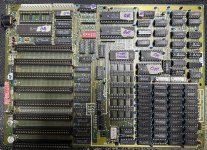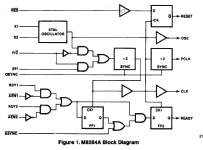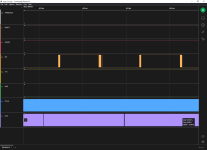Hello there,
I have this non-working XT turbo clone that isn’t booting - core chips are tested (on another XT board) and working.
I have tried replacing the 14MHz crystal but this being an XT turbo board I guess it does something funky with the keyboard to allow turbo using a combination of keys.
I can’t see a turbo jumper anywhere to force it to boot in 4.77MHz mode (which I guess it would do tying F/C to low to use the 14MHz crystal) so I guess that it boots in turbo mode.
Can I safely tie F/C to ground or do I risk damaging the turbo part of the circuit?
I have traced F/C going from the 8284 to pin 12 of the 74LS27 underneath the dip switches. Since it has only output it was easily traceable to pin 1 of one of the 74LS244 underneath, afterwards I wasn’t sure anymore of what to look for.
EFI instead goes from the 8284 to one of the 74LS244 below, on pin 7.
What else could I be looking for with just a multimeter? Ruud’s diagrom shows nothing with a known-working CGA card.
I haven’t got an oscilloscope (yet) but I am getting one soon. Still undecided on what to get since I work on a large array of retro systems and I haven’t got much in terms of budget. Heard good things of the DSO2512 but I was also looking at the DPOX180H.
Anyway, I haven’t been able to identify this board at all as it hasn’t got any markings expect that “Start” logo you can see on top of the 8255.
Thanks for helping!

I have this non-working XT turbo clone that isn’t booting - core chips are tested (on another XT board) and working.
I have tried replacing the 14MHz crystal but this being an XT turbo board I guess it does something funky with the keyboard to allow turbo using a combination of keys.
I can’t see a turbo jumper anywhere to force it to boot in 4.77MHz mode (which I guess it would do tying F/C to low to use the 14MHz crystal) so I guess that it boots in turbo mode.
Can I safely tie F/C to ground or do I risk damaging the turbo part of the circuit?
I have traced F/C going from the 8284 to pin 12 of the 74LS27 underneath the dip switches. Since it has only output it was easily traceable to pin 1 of one of the 74LS244 underneath, afterwards I wasn’t sure anymore of what to look for.
EFI instead goes from the 8284 to one of the 74LS244 below, on pin 7.
What else could I be looking for with just a multimeter? Ruud’s diagrom shows nothing with a known-working CGA card.
I haven’t got an oscilloscope (yet) but I am getting one soon. Still undecided on what to get since I work on a large array of retro systems and I haven’t got much in terms of budget. Heard good things of the DSO2512 but I was also looking at the DPOX180H.
Anyway, I haven’t been able to identify this board at all as it hasn’t got any markings expect that “Start” logo you can see on top of the 8255.
Thanks for helping!



